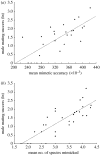Female preferences drive the evolution of mimetic accuracy in male sexual displays
- PMID: 17623632
- PMCID: PMC2391182
- DOI: 10.1098/rsbl.2007.0234
Female preferences drive the evolution of mimetic accuracy in male sexual displays
Abstract
Males in many bird species mimic the vocalizations of other species during sexual displays, but the evolutionary and functional significance of interspecific vocal mimicry is unclear. Here we use spectrographic cross-correlation to compare mimetic calls produced by male satin bowerbirds (Ptilonorhynchus violaceus) in courtship with calls from several model species. We show that the accuracy of vocal mimicry and the number of model species mimicked are both independently related to male mating success. Multivariate analyses revealed that these mimetic traits were better predictors of male mating success than other male display traits previously shown to be important for male mating success. We suggest that preference-driven mimetic accuracy may be a widespread occurrence, and that mimetic accuracy may provide females with important information about male quality. Our findings support an alternative hypothesis to help explain a common element of male sexual displays.
Figures


References
-
- Andersson M. Princeton University Press; Princeton, NJ: 1994. Sexual selection.
-
- Baylis J.R. Avian vocal mimicry: its function and evolution. In: Kroodsma D.E, Miller E.H, Ouellet H, editors. Acoustic communication in birds. Song learning and its consequences. vol. 2. Academic Press; New York, NY: 1982. pp. 51–83.
-
- Borgia G. Bower quality, number of decorations, and mating success of male satin bowerbirds, Ptilonorhynchus violaceus: and experimental analysis. Anim. Behav. 1985;33:266–271. doi:10.1016/S0003-3472(85)80140-8 - DOI
-
- Borgia G, Egeth M, Uy J.A.C, Patricelli G.L. Juvenile infection and male display: testing the bright male hypothesis across individual life histories. Behav. Ecol. 2004;15:722–728. doi:10.1093/beheco/arh067 - DOI
-
- Clark C.W, Marler P, Beaman K. Quantitative analysis of animal vocal phonology: an application to swamp sparrow song. Ethology. 1987;76:101–115.
Publication types
MeSH terms
Grants and funding
LinkOut - more resources
Full Text Sources

